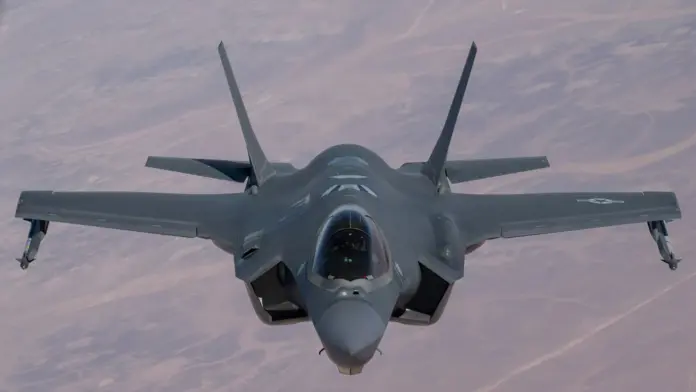For the first time, a U.S. F-35 jet was able to send secret battlefield information from Texas to a command center in Denmark over 5,000 miles away. The test demonstrated that the jet, in real time, could manage and distribute important intelligence to different locations around the world.
The Test: From Texas Skies to a Danish Command Center
From the Ebbing Air National Guard Base in Fort Smith, Arkansas (which will house a main training facility for Lockheed Martin), an F-35 aircraft sent encrypted data to be received by the Royal Danish Air Force’s operations center. It was the first time a U.S.-based F-35 sent secure data far enough to reach a European NATO partner’s real-time operational systems.
Thanks to advanced sensors and secure systems onboard, the aircraft forwarded up-to-date tactical, intelligence and operation details covering thousands of miles. The exercise showed how easily F-35 aircraft can work with the allied network which is now a key requirement in modern warfare.
The F-35 as a Digital Battlefield Hub
The F-35 Lightning II which Lockheed Martin produces, has earned a reputation as the most advanced combative jet in operation today. This isn’t only a stealth plane; it also acts as a command center, including advanced sensors and computer systems. They help the aircraft identify both potential threats and targets while sending this information on to ground and ship stations as well as to other nearby aircraft in real time.
Nicknamed the F-35 is because of its networked abilities which are what make it valuable today. Throughout the test, the aircraft served as a communication and intelligence platform, directly providing key information to coalition troops in Denmark while remaining secure over thousands of miles. This airborne intelligence role could bring major improvements to how multinational missions are coordinated.
Also read: What Is the Take It Down Act? New U.S. Law Explained
Strengthening NATO Interoperability
The emphasis on interoperation between NATO allies was a very important part of the exercise. Along with the United Kingdom, Norway, the Netherlands and Italy, Denmark has joined the F-35 program. It is important for these countries to share and exchange tactical details on their platforms so that NATO remains prepared to respond together.
With the growing instability in Eastern Europe and the Indo-Pacific, this method of communication allows NATO’s allies to move quickly, be exact and know what is happening. The ability to move mission-critical data during the test shows that F-35s go beyond just controlling the air—they are also important in digital combats and overall planning.
A Glimpse Into the Future of Warfare
The Texas-to-Denmark data transfer is part of a broader effort by the Pentagon to evolve warfare from isolated operations to network-centric strategies, where data, speed, and real-time communication shape success on the battlefield. With artificial intelligence, machine learning, and data fusion becoming increasingly important, the F-35’s digital infrastructure is designed to be future-proof.
Conclusion
The fact that a U.S.-operated F-35 shared data with Denmark reveals how stealth fighters are playing a growing part in world defense. It brings a big advance in the ability of NATO allies to collaborate, fight online and plan ways to defend together. Since seconds often matter in global defense, the F-35 is standing out as both a jet and a crucial part of the next generation of defense strategy.








